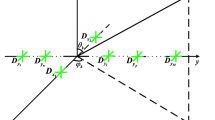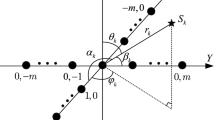Abstract
Many existing near-field source localization algorithms assume simplified models, for example, the Fresnel approximation model. Unlike these works, a new algorithm is herein proposed to localize multiple near-field electromagnetic sources under the exact source-array propagation model. Using the data measured by a linear (not necessarily uniform) cocentered orthogonal loop and dipole (COLD) array, three cumulant matrices are firstly defined to construct two matrix pencils. The magnitudes of the two matrix pencils’ generalized eigenvalues are then combined with their phases to extract the direction-of-arrival (DOA) and range estimates of the sources. The key idea of the new algorithm is to use a set of coarse estimates obtained from the magnitudes to resolve the set of ambiguous estimates obtained from the phases. In addition, the proposed algorithm estimates the polarizations without needing the prior estimation of the DOA-range parameters. This proposed algorithm is analytic, requires no iterative computations, and does not need to confine the inter-element spacing to be within a quarter wavelength.






Similar content being viewed by others
Data Availability Statement
The data used to support the findings of this study are available from the corresponding author upon request.
References
E. Boyer, A. Ferreol, P. Larzabal, Simple robust bearing-range source’s localization with curved wavefronts. IEEE Signal Process. Lett. 12(6), 457–460 (2005)
J.C. Chen, R.E. Hudson, K. Yao, Maximum-likelihood source localization and unknown sensor location estimation for wideband signals in the near-field. IEEE Trans. Signal Process. 50(8), 1843–1854 (2002)
H. Chen, W. Wang, W. Liu, Joint DOA, range, and polarization estimation for rectilinear sources with a COLD array. IEEE Wirel. Commun. Lett. 8(5), 1398–1401 (2019)
J.P. Delmas, M.N.E. Korso, H. Gazzah, M. Castella, CRB analysis of planar antenna arrays for optimizing near-field source localization. Signal Process. 127, 117–134 (2016)
M.C. Dogan, J.M. Mendel, Applications of cumulants to array processing. Part I: aperture extension and array calibration. IEEE Trans. Signal Process. 43(5), 1200–1216 (1995)
B. Friedlander, Localization of signals in the near-field of an antenna array. IEEE Trans. Signal Process. 67(15), 3885–3893 (2019)
E. Grosicki, K. Abed-Meraim, Y. Hua, A weighted linear prediction method for near-field source localization. IEEE Trans. Signal Process. 53(10), 3651–3660 (2005)
C. Guanghui, Z. Xiaoping, J. Shuang, Y. Anning, L. Qi, High accuracy near-field localization algorithm at low SNR using fourth-order cumulant. IEEE Commun. Lett. 24(3), 553–557 (2020)
J. He, M.O. Ahmad, M.N.S. Swamy, Extended-aperture angle-range estimation of multiple Fresnel-region sources with a linear tripole array using cumulants. Signal Process. 92(4), 939–953 (2012)
J. He, M.O. Ahmad, M.N.S. Swamy, Near-field localization of partially polarized sources with a cross-dipole array. IEEE Trans. Aerosp. Electron. Syst. 49(2), 857–870 (2013)
J. He, L. Li, T. Shu, Near-field parameter estimation for polarized source using spatial amplitude ratio. IEEE Commun. Lett. 24(9), 1961–1965 (2020)
J. He, L. Li, T. Shu, Localization of near-field sources for exact source-sensor spatial geometry. IEEE Signal Process. Lett. 27, 1040–1044 (2020)
J. He, L. Li, T. Shu, T.-K. Truong, Mixed near-field and far-field source localization based on exact spatial propagation geometry. IEEE Trans. Veh. Technol. 70(4), 3540–3551 (2021)
Y. Hsu, K.T. Wong, L. Yeh, Mismatch of near-field bearing range spatial geometry in source-localization by a uniform linear array. IEEE Trans. Antennas Propag. 59(10), 3658–3667 (2011)
Y.D. Huang, M. Barkat, Near-field multiple source localization by passive sensor array. IEEE Trans. Antennas Propag. 39(7), 968–975 (1991)
D.H. Johnson, D.E. Dudgeon, Array Signal Processing: Concepts and Techniques (Prentice-Hall, Upper Saddle River, NJ, USA, 1993)
H. Krim, M. Viberg, Two decades of array signal processing research: the parametric approach. IEEE Signal Process. Mag. 13(4), 67–94 (1996)
J. Li, P. Stoica, D. Zheng, Efficient direction and polarization estimation with a COLD array. IEEE Trans. Antennas Propag. 44(4), 539–547 (1996)
X. Li, Q. Gong, S. Zhong, S. Ren, Near-field noncircular sources localization based on fourth-order cumulant. IEEE Access 8, 120575–120585 (2020)
J. Li, Y. Wang, Z. Ren, X. Gu, M. Yin, Z. Wu, DOA and range estimation using a uniform linear antenna array without a priori knowledge of the source number. IEEE Trans. Antennas Propag. 69(5), 2929–2939 (2021)
J. Liang, D. Liu, Passive localization of near-field sources using cumulant. IEEE Sensors J. 9(8), 953–960 (2009)
S. Pasupathy, W.J. Alford, Range and bearing estimation in passive sonar. IEEE Trans. Aerosp. Electron. Syst. 16(2), 244–249 (1980)
R. Roy, T. Kailath, ESPRIT-estimation of signal parameters via rotational invariance techniques. IEEE Trans. Acoust. Speech Signal Process. 37(7), 984–995 (1989)
T. Shu, L. Li, J. He, Near-field localization for non-circular sources in the presence of sensor phase uncertainties. IEEE Wireless Commun. Lett. 10(3), 562–566 (2021)
T. Shu, J. He, L. Li, Near-field passive localization and gain-phase compensation with partly calibrated arrays. IEEE Trans. Aerosp. Electron. Syst. 58(1), 712–719 (2022)
T. Shu, J. He, V. Dakulagi, 3-D near-field source localization using a spatially spread acoustic vector sensor. IEEE Trans. Aerosp. Electron. Syst. 58(1), 180–188 (2022)
J. Tao, L. Liu, Z. Lin, Joint DOA, range, and polarization estimation in the fresnel region. IEEE Trans. Aerosp. Electron. Syst. 47(4), 2657–2672 (2011)
H.L. Van Trees, Optimum array processing, part IV of detection, estimation, and modulation theory (Wiley, New York, NY, USA, 2002)
A.J. van der Veen, P.B. Ober, E.F. Deprettere, Azimuth and elevation computation in high resolution DOA estimation. IEEE Trans. Signal Process. 40(7), 1828–1833 (1992)
M. Wax, T. Kailath, Detection of signals by information theoretic criteria. IEEE Trans. Acoust. Speech Signal Process. 33(4), 387–392 (1985)
A.J. Weiss, B. Friedlander, Range and bearing estimation using polynomial rooting. IEEE J. Ocean. Eng. 18(2), 130–137 (1993)
Y. Wu, L. Ma, C. Hou, G. Zhang, J. Li, Subspace-based method for joint range and DOA estimation of multiple near-field sources. Signal Process. 86(8), 2129–2133 (2006)
Y. Wu, H.C. So, C. Hou, J. Li, Passive localization of near-field sources with a polarization sensitive array. IEEE Trans. Antennas Propag. 55(8), 2402–2408 (2007)
J. Xu, B. Wang, F. Hu, Near-field sources localization in partly calibrated sensor arrays with unknown gains and phases. IEEE Wirel. Commun. Lett. 8(1), 89–92 (2019)
N. Yuen, B. Friedlander, Performance analysis of higher order ESPRIT for localization of near-field sources. IEEE Trans. Signal Process. 46(3), 709–719 (1998)
X. Zhang, W. Chen, W. Zheng, Z. Xia, Y. Wang, Localization of near-field sources: a reduced-dimension MUSIC algorithm. IEEE Commun. Lett. 22(7), 1422–1425 (2018)
T. Zhao, Z. Zhang, H. Chen, L. Qi, W. Liu, Augmented quaternion MUSIC method for near-field noncircular sources with a COLD array. IEEE Access 8, 212106–212113 (2020)
W. Zhi, M.Y.-W. Chia, Near-field source localization via symmetric subarrays. IEEE Signal Process. Lett. 14(6), 409–412 (2007)
W. Zuo, J. Xin, W. Liu, N. Zheng, H. Ohmori, A. Sano, Localization of near-field sources based on linear prediction and oblique projection operator. IEEE Trans. Signal Process. 67(2), 415–430 (2019)
W. Zuo, J. Xin, N. Zheng, H. Ohmori, A. Sano, Subspace based near-field source localization in unknown spatially nonuniform noise environment. IEEE Trans. Signal Process. 68, 4713–4726 (2020)
Author information
Authors and Affiliations
Corresponding author
Additional information
Publisher's Note
Springer Nature remains neutral with regard to jurisdictional claims in published maps and institutional affiliations.
Appendix A: Derivations of Eqs. (15)–(17)
Appendix A: Derivations of Eqs. (15)–(17)
Let \({\varvec{C}}_1(j, \ell )\) be the \((j, \ell )\)th entry of \({\varvec{C}}_1\). Then, \({\varvec{C}}_1(j, \ell )\) can be expressed as
where \(a_{m,k} = a_{m}(\theta _k, r_k)\) and \(b_{j, k}\) is the (j, k)th entry of \({\varvec{B}}\). In establishing (41), the fact that \(c_{1,k} c_{1,k}^*+ c_{2,k} c_{2,k}^*= 1\), \(\forall k\), is used. Expressing \({\varvec{C}}_1(j, \ell )\) for all \(j, \ell = 1, \ldots , 2M\) in matrix form, Eq. (15) is established.
Similarly, the \((j, \ell )\)th entries of \({\varvec{C}}_2(j, \ell )\) and \({\varvec{C}}_3(j, \ell )\) can be expressed, respectively, as
and
For all \(j, \ell = 1, \ldots , 2M\), \(p \in [1, M]\), and \(q \in [1, M]\), Eq. (42) yields (16) and eq. (43) yields (17).
Rights and permissions
About this article
Cite this article
Yin, K., Dai, Y. & Gao, C. Near-Field DOA-Range and Polarization Estimation Based on Exact Propagation Model with COLD Arrays. Circuits Syst Signal Process 41, 5183–5200 (2022). https://doi.org/10.1007/s00034-022-02029-z
Received:
Revised:
Accepted:
Published:
Issue Date:
DOI: https://doi.org/10.1007/s00034-022-02029-z




